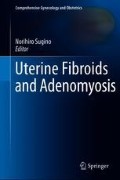Abstract
Uterine fibroids are benign tumors with a high prevalence rate and are considered the most common benign tumors in women of reproductive age. Surgical or medical treatment is necessary when symptoms, such as abnormal uterine bleeding, pelvic pain, and infertility, occur. Regarding hormonal therapies, a large number of GnRH agonist therapies have been employed. Current alternative treatments for the improvement of abnormal uterine bleeding and reduction of fibroid volume include GnRH antagonists, aromatase inhibitors, progestin, and selective progesterone receptor modulators, and their therapeutic effects have been studied.
Access this chapter
Tax calculation will be finalised at checkout
Purchases are for personal use only
References
Laughlin SK, et al. New directions in the epidemiology of uterine fibroids. Semin Reprod Med. 2010;28:204–17.
Stewart EA. Uterine fibroids. Lancet. 2001;357:293–8.
Buttram JVC, et al. Uterine leiomyomata: etiology, symptomatology, and management. Fertil Steril. 1981;36:433.
Manyonda IT, et al. Uterine artery embolization versus myomectomy: impact on quality of life-results of the FUME (Fibroids of the Uterus: Myomectomy versus Embolization) trial. Cardiovasc Intervent Radiol. 2012;35:530–6.
Stewart EA, et al. Clinical outcomes of focused ultrasound surgery for the treatment of uterine fibroids. Fertil Steril. 2006;85:22–9.
Ishikawa H, et al. Progesterone is essential for maintenance and growth of uterine leiomyoma. Endocrinology. 2010;151:2433–42.
Taylor DK, et al. Treatment for uterine fibroids: searching for effective drug therapies. Drug Discov Today Ther Strateg. 2012;9:e41–9.
Chang WC, et al. Comparison of laparoscopic myomectomy in large myomas with and without leuprolide acetate. J Minim Invasive Gynecol. 2015;22:992–6.
Muzii L, et al. GnRH analogue treatment before hysteroscopic resection of submucosal myomas: a prospective, randomized, multicenter study. Fertil Steril. 2010;94:1496–9.
Lethaby A, et al. Preoperative GnRH analogue therapy before hysterectomy or myomectomy for uterine fibroids. Cochrane Database Syst Rev. 2001;2:CD000547.
Fernandez H, et al. One year comparison between two add-back therapies in patients treated with a GnRH agonist for symptomatic endometriosis: a randomized double-blind trial. Hum Reprod. 2004;19:1465–1.
Felberbaum RE, et al. Treatment of uterine fibroids with a slow-release formulation of the gonadotrophin releasing hormone antagonist Cetrorelix. Hum Reprod. 1998;13:1660–8.
Kettel LM, et al. Rapid regression of uterine leiomyomas in response to daily administration of gonadotropin-releasing hormone antagonist. Fertil Steril. 1993;60:642–6.
Engel JB, et al. Presurgical short term treatment of uterine fibroids with different doses of cetrorelix acetate: a double-blind, placebo-controlled multicenter study. Eur J Obstet Gynecol Reprod Biol. 2007;134:225–32.
Gonzalez-Barcena D, et al. Treatment of uterine leiomyomas with luteinizing hormone-releasing hormone antagonist Cetrorelix. Hum Reprod. 1997;12:2028–35.
Dohan N, et al. Role of the aromatase inhibitor letrozole in the management of uterine leiomyomas in premenopausal woman. Eur J Obstet Gynecol Reprod Biol. 2013;171:329–32.
Parsanezhad ME, et al. A randomized, controlled clinical trial comparing the effects of aromatase inhibitor (letrozole) and gonadotropin-releasing hormone agonist (triptorelin) on uterine leiomyoma volume and hormonal status. Fertil Steril. 2010;93:192–8.
Song H, et al. Aromatase inhibitors for uterine fibroids. Cochrane Database Syst Rev. 2013;(10):CD009505.
Kriplani A, et al. Efficacy of the levonorgestrel-releasing intrauterine system in uterine leiomyoma. Int J Gynaecol Obstet. 2012;116:35–8.
Sayed GH, et al. A randomized clinical trial of a levonorgestrel-releasing intrauterine system and a low-dose combined oral contraceptive for fibroid-related menorrhagia. Int J Gynaecol Obstet. 2011;112:126–30.
Magalhães J, et al. Uterine volume and menstrual patterns in users of the levonorgestrel-releasing intrauterine system with idiopathic menorrhagia or menorrhagia due to leiomyomas. Contraception. 2007;75:193–8.
Marui T, et al. Effects of levonorgestrel-releasing IUS and progesterone receptor modulator PRM CDB-2914 on uterine leiomyomas. Contraception. 2007;75:S99–103.
Catherino WH, et al. Novel, orally active selective progesterone receptor modulator CB8947 inhibits leiomyoma cell proliferation without adversely affecting endometrium or myometrium. J Steroid Biochem Mol Biol. 2010;122:279–86.
Mutter GL, et al. The spectrum of endometrial pathology induced by progesterone receptor modulators. Mod Pathol. 2008;21:591–8.
Murphy AA, et al. Regression of uterine leiomyomata in response to the antiprogesterone RU 486. J Clin Endocrinol Metab. 1993;76:513–7.
Kulshrestha V, et al. Low dose mifepristone in medical management of uterine leiomyoma—an experience from a tertiary care hospital from north India. Indian J Med Res. 2013;137:1154–2.
Esteve JL, et al. Mifepristone versus placebo to treat uterine myoma: a double-blind, randomized clinical trial. Int J Women’s Health. 2013;5:361–9.
Tristan M, et al. Mifepristone for uterine fibroids. Cochrane Database Syst Rev. 2012;8:CD007687.
Biglia N, et al. Ulipristal acetate: a novel pharmacological approach for the treatment of uterine fibroids. Drug Des Devel Ther. 2014;8:285–92.
Talaulikar VS, et al. Ulipristal acetate: a novel option for the medical management of symptomatic uterine fibroids. Adv Devel Ther. 2012;29:655–63.
Fiscella K, et al. CDB-2914 for uterine leiomyomata treatment: a randomized controlled trial. Obstet Gynecol. 2008;112:707.
Nieman LK, et al. Efficacy and tolerability of CDB-2914 treatment for symptomatic uterine fibroids: a randomized, double-blinded, placebo-controlled, phase IIb study. Fertil Steril. 2011;95:767–2e1–2.
Donnez J, et al. Ulipristal acetate versus placebo for fibroid treatment before surgery. N Engl J Med. 2012;366:409–20.
Donnez J, et al. Ulipristal acetate versus leuprolide acetate for uterine fibroids. N Engl J Med. 2012;366:421–32.
Donnez J, et al. Long-term treatment of uterine fibroids with ulipristal acetate. Fertil Steril. 2014;101:1565–73.
Author information
Authors and Affiliations
Corresponding author
Editor information
Editors and Affiliations
Rights and permissions
Copyright information
© 2018 Springer Nature Singapore Pte Ltd.
About this chapter
Cite this chapter
Kusuki, I., Kitawaki, J. (2018). Current Medical Treatments for Uterine Fibroids. In: Sugino, N. (eds) Uterine Fibroids and Adenomyosis. Comprehensive Gynecology and Obstetrics. Springer, Singapore. https://doi.org/10.1007/978-981-10-7167-6_7
Download citation
DOI: https://doi.org/10.1007/978-981-10-7167-6_7
Published:
Publisher Name: Springer, Singapore
Print ISBN: 978-981-10-7166-9
Online ISBN: 978-981-10-7167-6
eBook Packages: MedicineMedicine (R0)

